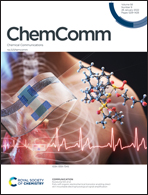Carbodiimide-fueled catalytic reaction cycles to regulate supramolecular processes
Abstract
Using molecular self-assembly, supramolecular chemists can create Gigadalton-structures with angstrom precision held together by non-covalent interactions. However, despite relying on the same molecular toolbox for self-assembly, these synthetic structures lack the complexity and sophistication of biological assemblies. Those assemblies are non-equilibrium structures that rely on the constant consumption of energy transduced from the hydrolysis of chemical fuels like ATP and GTP, which endows them with dynamic properties, e.g., temporal and spatial control and self-healing ability. Thus, to synthesize life-like materials, we have to find a reaction cycle that converts chemical energy to regulate self-assembly. We and others recently found that this can be done by a reaction cycle that hydrates carbodiimides. This feature article aims to provide an overview of how the energy transduced from carbodiimide hydration can alter the function of molecules and regulate molecular assemblies. The goal is to offer the reader design considerations for carbodiimide-driven reaction cycles to create a desired morphology or function of the assembly and ultimately to push chemically fueled self-assembly further towards the bottom-up synthesis of life.



 Please wait while we load your content...
Please wait while we load your content...